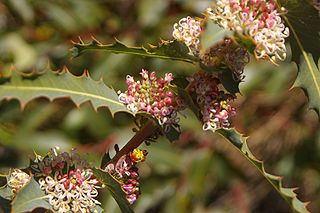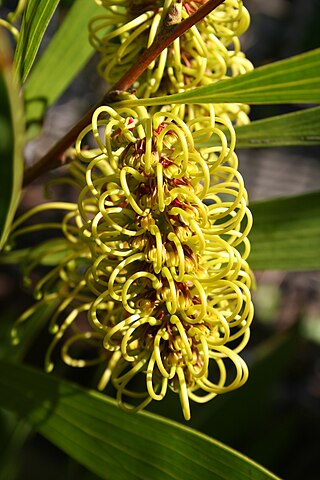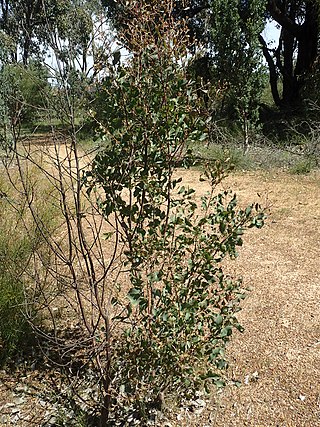
Hakea bakeriana is a shrub in the family Proteaceae. It is endemic to the Central Coast of New South Wales, Australia. It is a dense shrub with sharply pointed, cylinder-shaped leaves and pink to crimson flowers in groups of between four and twelve. The fruit is a rough, wrinkled follicle which terminates in a short beak.

Hakea cygna, commonly known as the swan hakea, is a species of flowering plant in the family Proteaceae. It usually grows as a dense shrub with creamy-white upright flowers appearing from July to August. It is endemic to Western Australia.

Hakea amplexicaulis, commonly known as prickly hakea, is a shrub endemic to south west Western Australia. An attractive small shrub with unusual stem clasping, sharply serrated foliage and a profusion of sweetly scented variable coloured flowers from late winter to spring.

Hakea clavata, commonly known as coastal hakea is a shrub that is endemic to an area along the south coast of Western Australia. It has thick leaves, pink and grey flowers and grows on rocky outcrops.

Hakea chordophylla, commonly known as bootlace oak, bootlace tree, corkwood, or bull oak, is a species of shrub or small tree in the family Proteaceae found in central and northern Australia. Bears very showy golden yellow, pale green or cream nectar rich flowers in winter.

Hakea cristata, commonly known as the snail hakea, is a shrub in the family Proteaceae native to Western Australia. An ornamental prickly shrub with attractive foliage and creamy white rounded flowers appearing in profusion in the winter months.

Hakea trineura is a flowering plant in the family Proteaceae and is endemic to Queensland. The branches and leaves are covered with rusty hairs and the pendulous flowers are greenish-yellow.
Hakea acuminata is a shrub of the family Proteaceae native to Western Australia. A restricted species bearing clusters of white flowers with a green or pinkish tinge in late autumn to winter.

Hakea anadenia is a shrub in the family Proteaceae, native to near the west coast of Western Australia. The fragrant creamy-white flowers appear in profusion from late winter to spring, but do not produce nectar.

Hakea auriculata is a species of flowering plant in the family Proteaceae endemic to Western Australia. A very showy species in full bloom with creamy white, yellow, dark red or reddish purple fragrant flowers.

Hakea bicornata is a shrub in the family Proteaceae native to Western Australia, with attractive creamy-white flowers and fruit with two distinctive horns.

Hakea candolleana is a shrub in the family Proteaceae native to areas along the west coast in the Wheatbelt and Mid West regions of Western Australia. A cream-white winter flowering species, useful as a garden ground cover.

Hakea circumalata is a shrub in the family Proteaceae native to an area in the Wheatbelt and Mid West regions of Western Australia. A small shrub producing a profusion of strongly scented pink to red flowers in dense clusters from July to September.

Hakea conchifolia, commonly known as the shell-leaved hakea, is a shrub in the family Proteaceae native to an area in the west coast of the Wheatbelt region of Western Australia. An attractive small species with unusual rigid leaves that encircle the flowers.

Hakea carinata is a species in the family Proteaceae native to an area in South Australia. It is a frost hardy small to medium shrub adaptable to a range of free draining situations. Its prickly habit creates a good wildlife habitat.

Hakea collina is a shrub in the Proteaceae native to eastern Australia. A small many branched shrub with gnarled branches with attractive cream-yellowish flowers.

Hakea divaricata, commonly known as needlewood, corkbark tree or fork-leaved corkwood, is a tree or shrub in the family Proteaceae native to an area in central Australia. A slow growing species with up to 120 showy cream to greenish-yellow flowers in long racemes from June to November.

Hakea stenophylla is a shrub or tree in the family Proteaceae, with sweetly scented creamy-white flowers. It is endemic to Western Australia.
Hakea leucoptera subsp. sericipes is a small tree with cylinder-shaped leaves and clusters of up to forty-five white fragrant flowers. It is found in northwestern New South Wales, Queensland and Western Australia.

Hakea persiehana is a shrub or small tree in the genus Hakea, which comprises approximately 150 species restricted to Australia. Most Hakea seed are usually dispersed by an environmental trigger rather than when seed matures, quite often by fire, whilst other species may require sporadic flooding rains to establish. Hakea is within the family Proteaceae



















